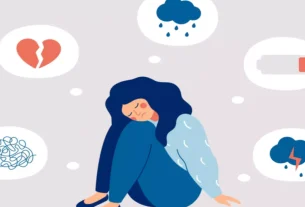Mania is one of the phases of bipolar disorder, a disorder also known as manic-depressive illness. It is characterized by a state of intense euphoria, with increased energy, agitation, restlessness, a desire for grandeur, less need for sleep, and can even cause aggression, delusions and hallucinations.
Hypomania, on the other hand, is a milder condition of mania, with less severe symptoms that interfere less with the person’s day-to-day life, and may include chatter, greater disposition, impatience, more sociability, initiative and energy to carry out daily activities.
People with bipolar disorder experience mood swings between bouts of mania or hypomania and depression. Generally, when alternating between episodes of mania and depression, the disease is classified as Bipolar disorder type 1. When it alternates between hypomania and depression, it is classified as Bipolar Disorder type 2. Understand what bipolar disorder is and its characteristics.

It is important to remember that not every change in mood indicates mania or bipolar disorder, as it is common for everyone to have small variations in mood throughout the day or week. To detect bipolar mania, it is necessary for the psychiatrist to carry out an assessment of the signs and symptoms and identify whether they are characteristic of the disease.
Main symptoms
Bipolar mania and hypomania cause feelings of euphoria that are far disproportionate to any positive event. The main symptoms include:
1. Mania Bipolar
The manic episode has symptoms that include:
- Excessive euphoria;
- Inflated self-esteem or delusion of grandeur;
- Talking excessively;
- Accelerated thinking, with flight of ideas;
- Too much distraction;
- Greater agitation or energy to carry out activities;
- Loss of control over your attitudes;
- Involvement in risky activities that normally require caution, such as foolish financial investments, unrestrained shopping or a greatly increased sexual appetite, for example;
- There may be irritability or aggressiveness;
- There may be delusions or hallucinations.
For the event to be characterized as mania, there must be at least 3 symptoms, which must last at least 4 days and persist for most of the day, or in cases where they are so severe as to require hospitalization.
These symptoms are so intense that they tend to disrupt the social and professional relationships of the person with the disease, being considered a medical and social emergency, which must be treated as soon as possible.
2. Hypomania
The signs and symptoms of a hypomanic episode are similar to those of mania, however, they are milder. The main ones include:
- Euphoria or elevated mood;
- Greater creativity;
- Reduced need for sleep, being rested after sleeping about 3 hours, for example;
- Talking more than usual or chatting;
- Accelerated thinking;
- Easy distraction;
- Agitation or increased energy to carry out activities;
- Easily carry out activities that would require greater caution, such as unrestrained purchases, risky financial investments and increased sexual appetite.
Symptoms of hypomania do not usually cause harm to social and professional relationships, nor do they cause symptoms such as delusions or hallucinations, in addition to usually lasting a short time, around 1 week.
Furthermore, they are not serious enough to require hospitalization, and in some cases, they may even go unnoticed. In these cases, many patients end up being treated as just having depression, as the mood swings may not be detected.
Read too: Bipolar depression: symptoms and how to treat (with online test)
How to confirm
The episode of mania or hypomania is identified by the psychiatrist, who will evaluate the symptoms reported by the patient or by people close to them.
Make an appointment with a psychiatrist in the region closest to you:
Taking care of your health has never been easier!
It is also important that the doctor carries out evaluations and tests that can rule out other diseases or situations that cause similar symptoms, such as thyroid dysregulation, side effects of medications, such as corticosteroids, use of illicit drugs or other psychiatric illnesses, such as schizophrenia or personality disorders. , for example.
Also check out the main mental disorders and how to identify each one.
How to deal with
The treatment of bipolar disorder is guided by a psychiatrist, using medications that stabilize mood, such as lithium or valproate, for example. Antipsychotics, such as Haloperidol, Quetiapine or Olanzapine, may also be indicated to calm behavior and reduce psychotic symptoms.
Psychotherapy provided by a psychologist is very useful in helping the patient and family deal with mood changes. Anxiolytics may also be indicated in cases of severe agitation and, in addition, in severe or treatment-resistant cases, electroconvulsive therapy may be indicated.
Learn more details about treatment options for bipolar disorder.
Bibliography
- BAHJI, A.; et al. Comparative efficacy and tolerability of pharmacological treatments for the treatment of acute bipolar depression: A systematic review and network meta-analysis. J Affect Disord. 269. 154-184, 2020
- DIAZ, A.; et al. Treatment-resistant bipolar depression: concepts and challenges for novel interventions. Braz J Psychiatry. 44. 2; 178-186, 2022
- BALDESSARINI, RJ; et al. Bipolar depression: a major unsolved challenge. International Journal of Bipolar Disorders. 8. 1; 1-13, 2020
- McINTYRE, R. S.; CALABRESE, J. R. Bipolar depression: the clinical characteristics and unmet needs of a complex disorder. Curr Med Res Opin. 35. 11; 1993-2005, 2019

Sign up for our newsletter and stay up to date with exclusive news
that can transform your routine!
Warning: Undefined array key "title" in /home/storelat/public_html/wp-content/plugins/link-whisper-premium/templates/frontend/related-posts.php on line 12
Warning: Undefined array key "title_tag" in /home/storelat/public_html/wp-content/plugins/link-whisper-premium/templates/frontend/related-posts.php on line 13




